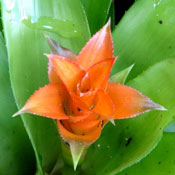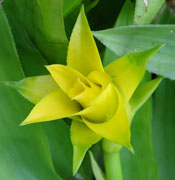GENERA
Canistropsis

Canistropsis derives its name from the genus Canistrum and the Greek "opsis" meaning resembling. There are only 11 species, all originally found in Brazil. Some of the small bromeliads that previously were in Nidularium have been reclassified as Canistropsis. They were called Nidularium citrinum at one time, which is the name most of us know them by. They are about eight inches across, have light green leaves, bright yellow bracts, and tiny white flowers. If you went to Helen Friend’s house after our last meeting, you saw a large bed of them lining the walkway just past her house.
A plant with a different coloration was called Nidularium purpurata, but it was combined with citrinum and renamed Nidularium billbergioides. They have both now been classified in Canistropsis and given a varietal name based on the color: Apricot, Blood Orange, Citron, Guava, Lemon, Mulberry, Persimmon, Tamarillo, and Tutti Frutti. Although Canistropsis ‘Citron’ is the most common variety we see in Hawai‘i, Mary Louise Boyd has a small patch of ‘Persimmon.’ These are shade-loving plants, very easy to grow, and multiply readily. Give them the same care you would Vriesea and Guzmania.
If you would like more information, we have a book by Elton Leme in our library, Canistropsis: Bromeliads of the Atlantic Forest. To check it out, see Lynette Wageman at our next meeting.

Canistropsis 'Persimmon'

Canistropsis 'Citron'
This site best viewed using Mozilla Firefox | Page last revised: 01.27.2011